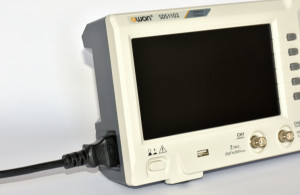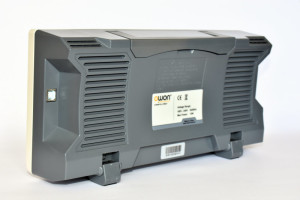Review: Owon SDS1102 Budget Oscilloscope
Features

the side, I don't find that very convenient.
Considering the price of the SDS1102, you cannot expect too much from this instrument. But as we already mentioned, the sampling rate and bandwidth are excellent. The maximum input sensitivity of 5 mV/div is reasonable, this will be sufficient for most measurements. The trigger menu is quite limited with the choice between edge and video, but that does keep things very manageable. The number of measurement values that you can display on the screen is, however, very extensive with 30 available. Both horizontal and vertical cursor lines can be displayed and can be used to make a number of different measurements.
The sample buffer is a little on the small side with only 10 ksamples. This perhaps could have been a little bigger, although you would have to question whether that is really necessary on a simple oscilloscope. In any case, it is easy to scroll through the memory buffer and zoom in on certain parts.
There is also a Math-button present that you can use to carry out a number of operations on the input signals. This is also limited with only +, -, x, : and inverting, but these are nevertheless the most important functions. Remarkable is the fact that this scope does have an FFT function with quite a few configuration settings, such as different types of measuring windows. Make sure that you set the time base so that quite a few cycles of the signal are visible in the time-domain window, otherwise you will not get a reliable FFT measurement (this is true for all oscilloscopes).
In practice

For a basic oscilloscope I had, to be honest, expected much less. When compared to a much more expensive instrument, it misses out on many adjustment options and additional features, although when it comes to displaying waveforms that are not too complex it functions very well. The Owon SDS1102 offers an excellent price/quality trade-off and is certainly highly recommended for anyone who needs a usable oscilloscope for not much money.
By the way, you can go even much cheaper if you are satisfied with a lower bandwidth. The Owon SDS1022 has the same enclosure and features, but has a lower input bandwidth (20 MHz) and a lower sampling rate (100 MHz) for a price of only 190 euro (171 euro for Elektor members).


Discussion (0 comments)